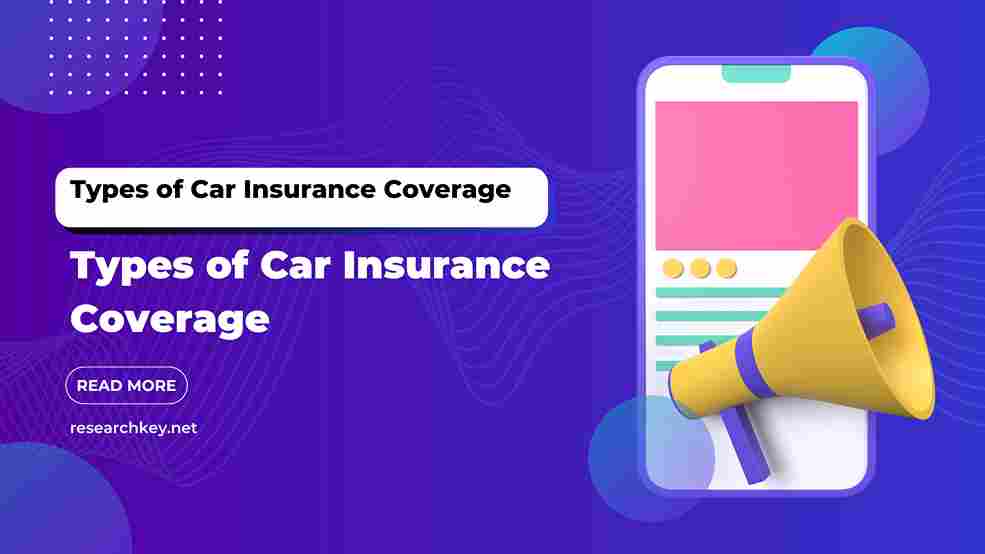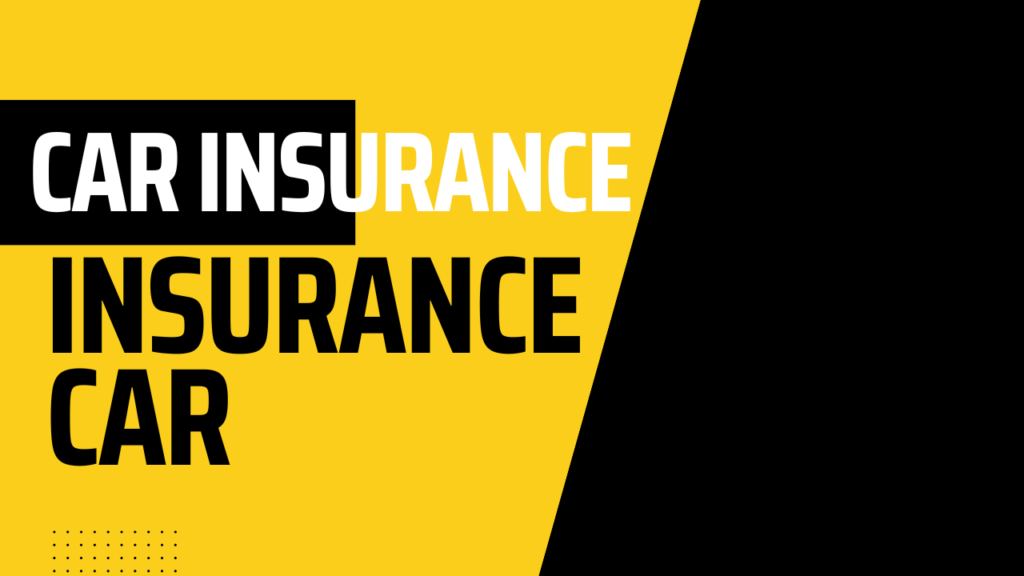Types of Car Insurance Coverage
Car insurance is an important aspect of owning a vehicle. Not only is it legally required in most states, but it also provides financial protection in the event of an accident or other covered event.
In this article, we’ll dive deeper into the world of car insurance, exploring the different types of coverage, how car insurance premiums are calculated, and tips for finding the best car insurance policy for your needs.
Types of Car Insurance Coverage
There are several types of car insurance coverage, each with its own set of benefits and limitations.
Understanding the different types of coverage can help you make an informed decision when shopping for car insurance. Here’s a breakdown of the most common types of car insurance coverage:
Liability Coverage
Liability coverage is an essential type of car insurance coverage that protects you if you’re responsible for causing damage to someone else’s property or injuring someone in an accident.
Liability coverage is a legal requirement in most states, and it typically includes two types of coverage: bodily injury liability and property damage liability.
Bodily injury liability coverage pays for the cost of medical bills, lost wages, and other damages if you injure someone in an accident.
For example, if you rear-end another driver and they suffer whiplash, your bodily injury liability coverage would pay for their medical bills and any other related expenses.
Bodily injury liability coverage may also cover the cost of legal fees if the injured party decides to sue you.
Property damage liability coverage pays for the cost of repairing or replacing other people’s property that you damage in an accident, such as their car or mailbox.
For example, if you accidentally hit a parked car and cause damage to the other vehicle, your property damage liability coverage would pay for the cost of repairs to the other driver’s car.
It’s important to note that liability coverage only covers damage or injuries you cause to other people, not yourself or your own property.
If you’re involved in an accident and you’re at fault, liability coverage can help protect you from financial ruin by paying for the damages you caused.
Liability coverage typically has limits, which are the maximum amount your insurance company will pay for damages or injuries.
For example, if you have $50,000 in bodily injury liability coverage and you injure someone in an accident, your insurance company will pay up to $50,000 in medical bills and related expenses.
If the damages exceed your policy limit, you may be responsible for paying the difference out of pocket.
The amount of liability coverage you need will depend on several factors, including:
Your state’s minimum requirements: Each state has its own minimum requirements for liability coverage, and you’ll need to purchase at least this amount to legally drive in the state.
Your assets: If you have a lot of assets, such as a home or savings account, you may want to consider purchasing higher levels of liability coverage to protect your assets in the event of a lawsuit.
Your risk factors: If you have a history of accidents or traffic violations, you may want to purchase higher levels of liability coverage to protect yourself from potential lawsuits.
In conclusion, liability coverage is a crucial type of car insurance coverage that can protect you from financial ruin if you’re responsible for causing damage or injury to someone else in an accident.
It’s important to purchase enough liability coverage to protect yourself and your assets, and to comply with your state’s minimum requirements.
Related posts: Reliable Auto Insurance Near Me(2023)
Collision Coverage
Collision coverage is a type of car insurance coverage that pays for damages to your own vehicle in the event of a collision with another vehicle or object.
This coverage is not legally required, but it is often recommended for drivers who want extra protection for their own vehicle.
If you are involved in a collision and you have collision coverage, your insurance company will pay for the cost of repairing or replacing your vehicle, up to the actual cash value of the vehicle.
Actual cash value is the amount your car is worth at the time of the accident, taking into account factors such as its age, condition, and mileage.
Collision coverage typically has a deductible, which is the amount you must pay out of pocket before your insurance company will pay for the remaining cost of repairs.
For example, if you have a $500 deductible and your car needs $1,500 in repairs after a collision, you would pay the first $500 and your insurance company would pay the remaining $1,000.
It’s important to note that collision coverage only covers damage to your own vehicle, not to other people’s property or injuries.
If you’re involved in an accident and you’re at fault, liability coverage would cover the cost of damages and injuries to other people, while collision coverage would cover the cost of repairs to your own vehicle.
The cost of collision coverage can vary depending on several factors, including:
Your deductible: Higher deductibles typically result in lower premiums, while lower deductibles result in higher premiums.
The make and model of your vehicle: More expensive vehicles may have higher premiums due to the cost of repairs or replacement.
Your driving history: If you have a history of accidents or traffic violations, you may have higher premiums due to the increased risk of a collision.
It’s important to consider the cost of collision coverage when purchasing car insurance, as it can significantly impact your overall premium. If you have a newer or more expensive vehicle, collision coverage may be worth the additional cost to protect your investment.
In conclusion, collision coverage is a type of car insurance coverage that pays for damages to your own vehicle in the event of a collision with another vehicle or object.
While it is not legally required, it can provide extra protection for your own vehicle and may be worth considering for newer or more expensive vehicles.
Be sure to consider the cost of collision coverage when purchasing car insurance, and choose a deductible and coverage amount that best fits your needs and budget.
Comprehensive Coverage
Comprehensive coverage is a type of car insurance coverage that protects you from damage or loss to your vehicle that is not caused by a collision.
This coverage is also known as “other than collision” coverage and is optional, but it can provide valuable protection for your vehicle.
Comprehensive coverage typically covers the following:
Theft: If your car is stolen, comprehensive coverage will pay for the actual cash value of your vehicle, up to your policy limit.
Vandalism: If your vehicle is damaged due to vandalism, comprehensive coverage will pay for the cost of repairs, up to your policy limit.
Natural disasters: If your vehicle is damaged due to a natural disaster, such as a hurricane or tornado, comprehensive coverage will pay for the cost of repairs or replacement, up to your policy limit.
Falling objects: If your vehicle is damaged by a falling object, such as a tree or debris, comprehensive coverage will pay for the cost of repairs or replacement, up to your policy limit.
Animal damage: If your vehicle is damaged by an animal, such as hitting a deer, comprehensive coverage will pay for the cost of repairs or replacement, up to your policy limit.
Like collision coverage, comprehensive coverage has a deductible, which is the amount you must pay out of pocket before your insurance company will pay for the remaining cost of repairs or replacement.
The cost of comprehensive coverage can vary depending on several factors, including:
The make and model of your vehicle: More expensive vehicles may have higher premiums due to the cost of repairs or replacement.
Your deductible: Higher deductibles typically result in lower premiums, while lower deductibles result in higher premiums.
Your location: If you live in an area prone to natural disasters, such as hurricanes or tornadoes, you may have higher premiums due to the increased risk of damage.
It’s important to note that comprehensive coverage only covers damage or loss to your own vehicle, not to other people’s property or injuries. If you’re involved in an accident and you’re at fault, liability coverage would cover the cost of damages and injuries to other people, while collision coverage would cover the cost of repairs to your own vehicle.
In conclusion, comprehensive coverage is a type of car insurance coverage that protects you from damage or loss to your vehicle that is not caused by a collision.
While it is optional, it can provide valuable protection for your vehicle in the event of theft, vandalism, natural disasters, falling objects, or animal damage.
Be sure to consider the cost of comprehensive coverage when purchasing car insurance, and choose a deductible and coverage amount that best fits your needs and budget.
Personal Injury Protection (PIP) Coverage
Personal Injury Protection (PIP) coverage helps pay for medical expenses and lost wages if you or your passengers are injured in an accident.
PIP coverage is sometimes referred to as “no-fault” insurance because it covers medical expenses regardless of who is at fault for the accident.
PIP coverage is required by law in some states, but it’s not available in all states. If it’s available in your state, you may be required to purchase it in addition to your liability coverage.
Uninsured/Underinsured Motorist Coverage
Uninsured/Underinsured Motorist Coverage is a type of car insurance coverage that provides protection for you and your passengers if you are involved in an accident with a driver who either does not have insurance or has insufficient insurance to cover the damages and injuries caused by the accident.
In some states, uninsured/underinsured motorist coverage is mandatory, while in others it is optional. However, even if it is not required by law, it is still a good idea to consider this type of coverage to protect yourself in case of an accident with an uninsured or underinsured driver.
Uninsured motorist coverage provides protection if you are involved in an accident with a driver who does not have any insurance. This coverage can help pay for your medical bills, lost wages, and other expenses that result from the accident. It can also cover damages to your vehicle.
Underinsured motorist coverage provides protection if you are involved in an accident with a driver who has insurance, but their insurance policy limits are not enough to cover the damages and injuries caused by the accident.
This coverage can help cover the difference between the at-fault driver’s insurance policy limits and the actual cost of damages and injuries.
The cost of uninsured/underinsured motorist coverage can vary depending on several factors, including:
The state you live in: Some states require this coverage, while others make it optional.
Your driving record: If you have a history of accidents or traffic violations, you may have higher premiums due to the increased risk of being involved in an accident.
The coverage limits you choose: The higher the coverage limits you choose, the higher your premiums will be.
It’s important to note that uninsured/underinsured motorist coverage only covers damages and injuries caused by an uninsured or underinsured driver, not damages or injuries caused by you.
If you’re at fault in an accident, liability coverage would cover the cost of damages and injuries to other people.
In conclusion, uninsured/underinsured motorist coverage is a type of car insurance coverage that provides protection for you and your passengers if you are involved in an accident with a driver who does not have insurance or has insufficient insurance.
While it is not always required by law, it is still a good idea to consider this type of coverage to protect yourself in case of an accident with an uninsured or underinsured driver.
Be sure to consider the cost of uninsured/underinsured motorist coverage when purchasing car insurance, and choose coverage limits that best fit your needs and budget.
How Car Insurance Premiums are Calculated
Car insurance premiums are the amount you pay for car insurance coverage over a certain period, usually a year.
The cost of car insurance premiums can vary widely depending on several factors. Below are some of the main factors that insurers consider when calculating car insurance premiums:
Your driving history: Insurance companies look at your driving history, including your driving record, claims history, and any previous accidents or violations. If you have a clean driving history, you are likely to get a lower premium.
Your age and gender: Younger drivers and male drivers tend to have higher premiums than older drivers and female drivers.
This is because younger and male drivers are considered riskier to insure due to their lack of driving experience and higher likelihood of accidents.
Your location: Your ZIP code or city can impact your insurance rates. If you live in an area with a higher incidence of accidents or theft, you are likely to pay more for car insurance.
Your vehicle: The make, model, and age of your car can also impact your insurance rates. Newer or more expensive cars typically have higher premiums due to their higher value and repair costs.
Your coverage: The type and amount of coverage you choose can also impact your premium. The more coverage you have, the higher your premium will be.
Your deductible: The amount you choose for your deductible can also affect your premium. A higher deductible typically results in a lower premium, while a lower deductible results in a higher premium.
Discounts: Insurance companies may offer discounts for various reasons, such as safe driving, bundling multiple policies, or having certain safety features on your car.
It’s important to note that each insurance company has its own formula for calculating car insurance premiums.
Therefore, it’s essential to shop around and compare rates from different insurance providers to find the best coverage and premium for your needs and budget.
In conclusion, car insurance premiums are calculated based on several factors, including your driving history, age and gender, location, vehicle, coverage, deductible, and discounts.
Insurance companies use these factors to determine the level of risk you pose as a driver and to set your insurance premiums. Be sure to shop around and compare rates to find the best coverage and premium for your needs and budget.
Types of Car Insurance Coverage, Types of Car Insurance Coverage, Types of Car Insurance Coverage
Types of Car Insurance Coverage, Types of Car Insurance Coverage, Types of Car Insurance Coverage, Types of Car Insurance Coverage, Types of Car Insurance Coverage, Types of Car Insurance Coverage
Types of Car Insurance Coverage, Types of Car Insurance Coverage, Types of Car Insurance Coverage, Types of Car Insurance Coverage, Types of Car Insurance Coverage, Types of Car Insurance Coverage



